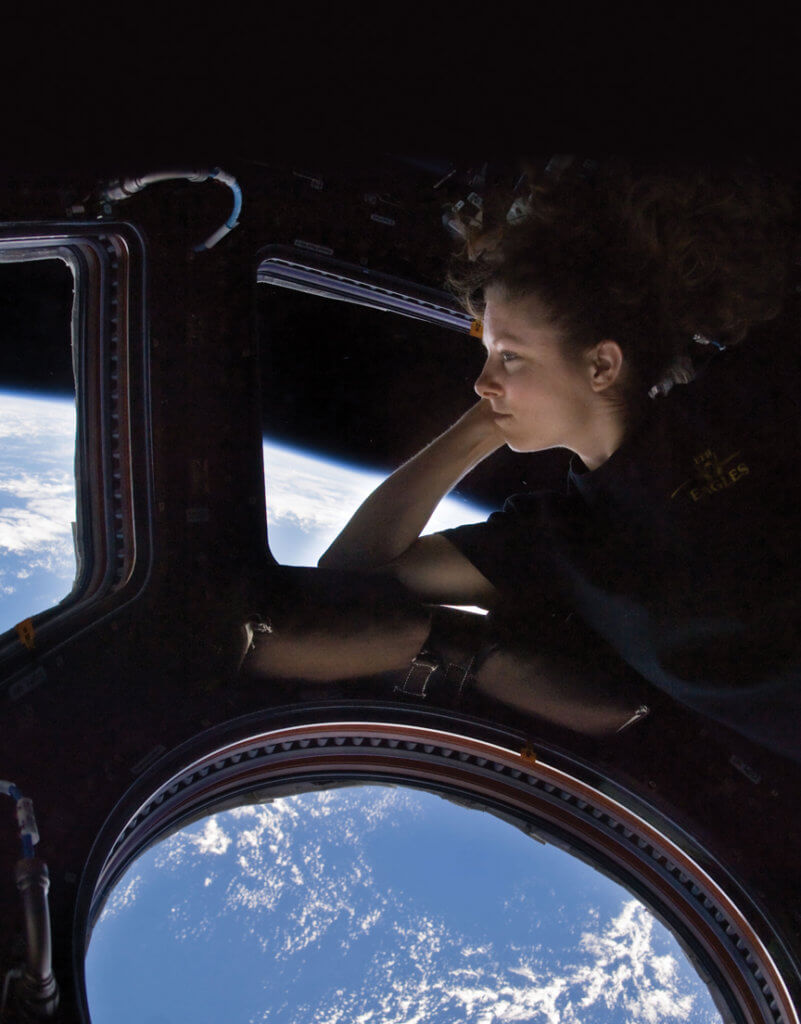
Update: NASA astronaut and alumna Tracy Dyson, a Roscosmos cosmonaut and spaceflight participant will launch at 5:36 a.m. PT on Saturday, March 23, to the International Space Station. Coverage begins at 5 a.m. PT. The crew will spend two days in orbit before docking to the station’s Prichal module on Monday, March 25. To watch, visit NASA. For more information, visit NASA’s space station blog or here.
Update: The March 21 launch of the crewed Soyuz-25 spacecraft to the International Space Station with NASA astronaut Tracy C. Dyson and two crew mates was scrubbed. Information is pending on what caused the launch abort. Visit NASA’s blog for details.
It’s been 14 years since NASA astronaut and chemistry alumna Tracy C. Dyson launched into space to live and work on the International Space Station.
For her third mission, Dyson launches to the space station March 21 on a Russian spacecraft as a member of the Expedition 70/71 crew.
“I’m a little older, wiser and more experienced,” said Dyson, a 1993 Cal State Fullerton graduate. “As a flight engineer, I’m thrilled to be able to serve the station and our international partners to keep the mission going.”
Dyson is looking forward to the possibility of performing breathtaking spacewalks, conducting pioneering experiments, and witnessing firsthand the improvements and changes aboard the space station over the last decade.
Since 2000, humans have continuously lived and worked aboard the space station to advance scientific knowledge and new technologies and make research breakthroughs not possible on Earth.
Dyson will launch on the Roscosmos Soyuz MS-25 spacecraft and will spend about six months aboard the state-of-the-art orbiting laboratory, a collaboration of 15 nations. She will travel to the station with a Roscosmos cosmonaut and a space tourist who will spend approximately 12 days aboard the orbital complex.
A 25-year astronaut and chemist, Dyson has worked in the Mission Control Center at NASA’s Johnson Space Center in Houston as a spacecraft communicator for space shuttle and space station operations.
A Titan in Space
Dyson’s last assignment on the space station was in 2010 as part of Expedition 23/24. She spent 176 days in space and performed three successful — and unplanned — spacewalks to make critical repairs, logging 22 hours and 49 minutes outside the station. She assisted in removing and replacing a failed pump module for one of two external ammonia circulation loops that keep internal and external equipment cool.
“Everything you’ve been studying goes right out the window,” Dyson recalled of her first spacewalk. “But I knew what I had to do. It was rewarding.”

Dyson relayed that it took her breath away when she first stepped outside the space station hatch: “The first thing you see is our planet if the sun is out; if not, you see this blackness that you’ve never encountered in your life, and you have to overcome that gulp to find your bearings.”
As a veteran astronaut and spacewalker, Dyson is eager to assist fellow crew members on their spacewalk — if the need arises — during this latest mission.
“It would be an honor to lead others on their first spacewalk and make sure they stay safe and are successful,” she said.
As part of the Expedition 70/71 crew, Dyson will conduct scientific investigations and technology demonstrations that help prepare humans for future space missions and benefit people on Earth. Among the experiments she’ll be working on includes studying how fire spreads and behaves in space.
Dyson will also contribute to the station’s “Crew Earth Observations” study by photographing Earth to understand how the planet is changing over time.
Journey to the Stars
After graduating from CSUF, Dyson pursued graduate school at UC Davis. A year after earning a doctorate in chemistry, NASA selected her as an astronaut in June 1998.
Almost a decade later, in 2007, she launched aboard the space shuttle Endeavour on STS-118 for a 12-day mission. As a mission specialist, she lived on the shuttle, docked next to the space station, and assisted in adding the starboard-5 truss segment to the station’s “backbone” and a new gyroscope.

The first in her family to graduate from college, Dyson participated on the track and field team as a sprinter and long jumper and recalled fond memories of her journey at Cal State Fullerton.
“In my heart, I am still connected to Cal State Fullerton. Going to college was a brand new world for me. It was the best place to grow up academically,” she said. “As an undergrad, I had constant contact with professors who were so passionate about what they did. I am so grateful when I look back on my time there.”
She returned to her alma mater in 2012 to share her space career with students and reconnect with faculty mentors, including retired chemistry professors Scott Hewitt and John Olmsted. In 2020, during the pandemic, she delivered a video message to the university’s graduating class.
As NASA prepares to land humans on the moon again in the coming years with its Artemis missions, Dyson admitted that she would like to be part of future lunar space exploration — and even Mars.
After all, Dyson, the first astronaut selected born after the first Apollo 11 moon landing in 1969, wrote this message in a friend’s high school yearbook 20 years later: “I’ll wave to you on my way to the moon.”
“To be able to go to the moon and do meaningful work to understand the moon better and its relationship to Earth — I can’t think of a better way to do that than to be part of those missions.”